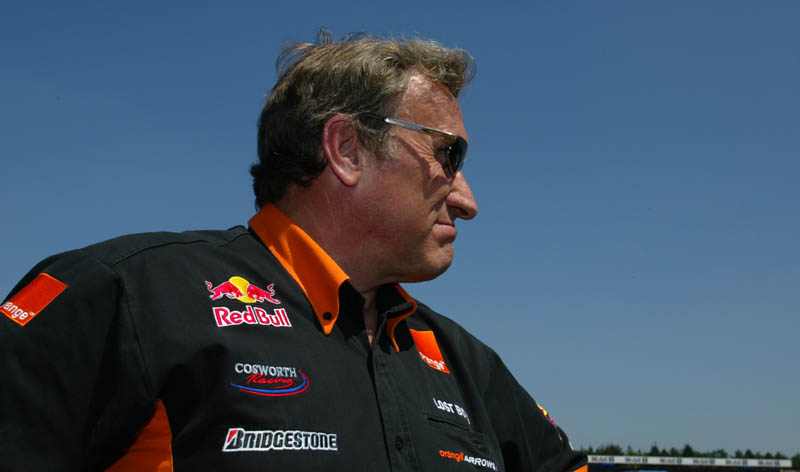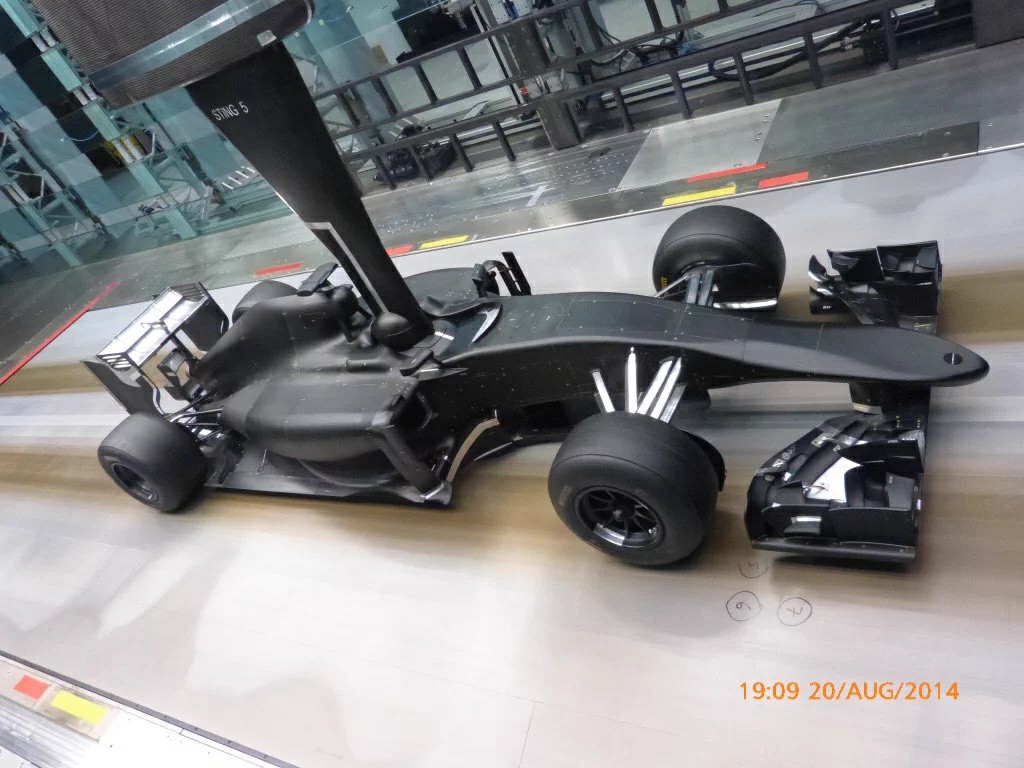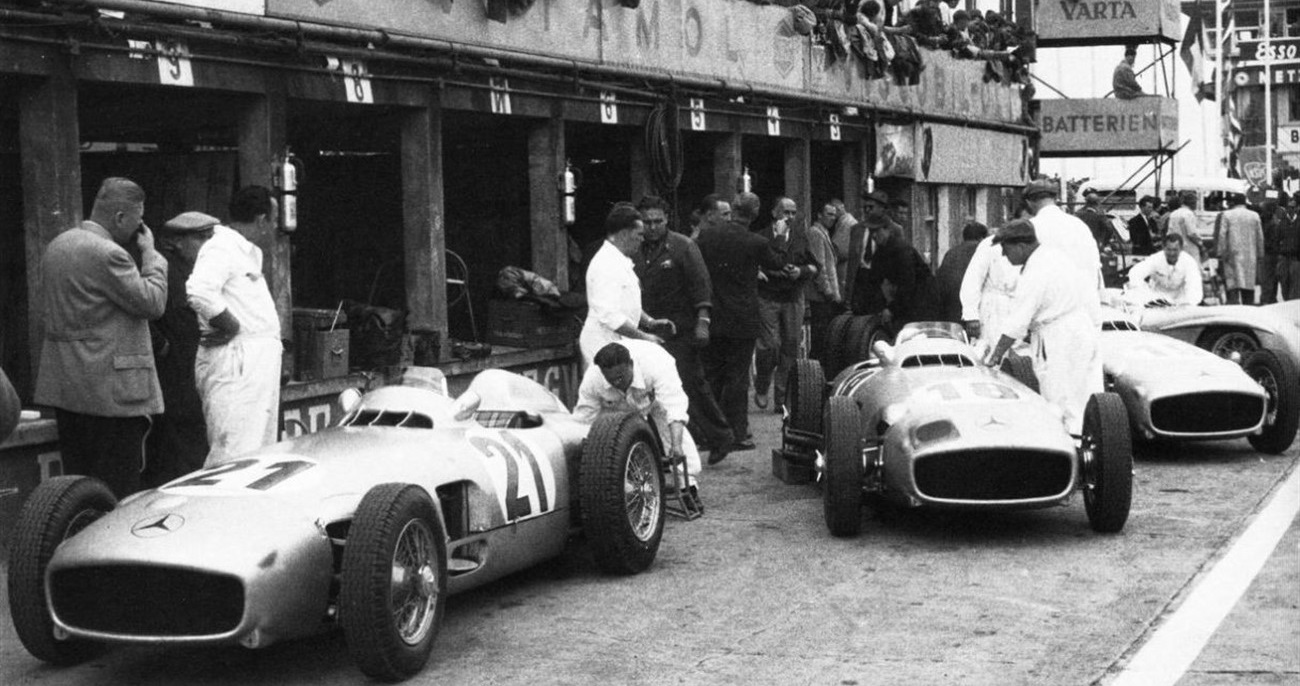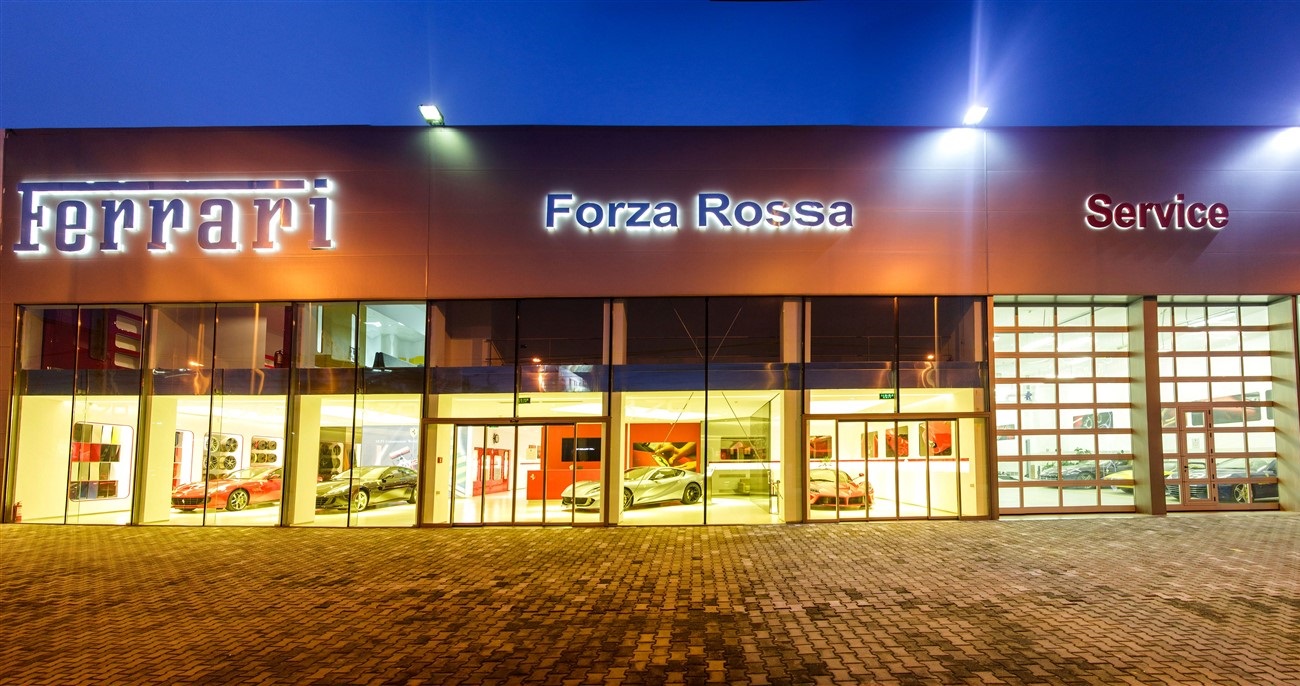The legend says that the phoenix will rise from its ashes. Formula One almost had its own phoenix legend, with a new team named Phoenix Grand Prix, rising from the ashes of the bankrupted Prost Grand Prix. The investors behind the project bought the assets and entry of the Prost team, or at least they thought they had. Here is the story of one of the most mysterious Formula One teams ever: full of intrigue, the Arrows 3 seater, Tom Walkinshaw, a five year old F1 engine, and a bizarre team structure, all better known as the stillborn Phoenix Grand Prix team.
Note 1: I want to thank Jon Hilton for his information about the Phoenix Grand Prix team. He was in charge of the engine programme. The email he sent to me is published within the article.
Note 2: I made contact with Charles Nickerson about the Phoenix Grand Prix team. However he was unwilling to co-operate to allow the article to be completed. After a short exchange he stopped answering my emails.
Note 3: The team was present at several race weekends. However there are no pictures of team members or the car of the Phoenix Grand Prix team.
Prost Grand Prix found themselves in serious financial trouble during the 2000 F1 season. With a poorly developed car, the AP03, Prost failed to score a single point all year, despite employing two very capable drivers in Jean Alesi and Nick Heidfeld. Peugeot, having produced the unreliable A20 engine which hampered the team even further, decided to scrap their engine program after seven years in the sport leaving the team without an engine supply for the following year. Matters deteriorated further when the team’s title sponsor Gauloises ended their activities in F1. But despite these major setbacks, the Prost team managed to survive during the winter of 2000 and into 2001. A deal was struck with Ferrari to supply the team with engines, rebadged as Acer in a similar sponsorship deal that saw Sauber’s Ferrari engines badged as Petronas units. The new AP04 was a good car which showed potential, but financial problems continued to hang over the team and over the course of 2001 five different drivers would occupy a Prost car at one point or another.
After the season finale in Japan, rumours began circulating in the paddock speculating about Prost’s financial status and the possibility that the team would go bankrupt. Alain Prost stated at the time that the team was preparing as normal for 2002 and that it would appear on the grid in Melbourne. We all know now that this didn’t happen and at the time Alain Prost probably knew this too. Just before the 2002 season started Prost Grand Prix was liquidated. Then, out of nowhere on 1st March it was announced that the “Prost Team” would appear on the grid after all. Behind this deal was Tom Walkinshaw, at that time the owner of Arrows, a Formula One team that was also struggling financially. Tom had an impressive career in team management both from within and outside of Formula One and it seemed that he could deal with two teams.
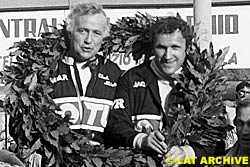
Charles Nickerson & Tom Walkinshaw
Charles Nickerson, a good friend of Tom Walkinshaw and an excellent rally driver in the past, was the man behind the survival of Prost GP, buying the team’s assets with his company Phoenix Finance Ltd. for a rumoured figure of £2.5 million. With the purchase complete, the new owners faced their first obstacle in the paddock as Minardi owner Paul Stoddart immediately opposed the team’s re-entry into F1. During the off-season Prost had already started designing their new AP05 car, with pictures of their wind tunnel model leaked on the internet. The design looked promising. Fellow struggler’s Minardi, which had been bought by Stoddart a year earlier, stood to gain an awful lot by purchasing the AP05 designs for themselves, preventing another team from entering and guaranteeing themselves the lucrative tenth place on the grid and its associated prize money and travel benefits. As time went by, Stoddart would prove to be just one of many opponents to Phoenix Finance’s attempts to enter Formula One.
Once the takeover of Prost by Phoenix Finance was confirmed, attention turned to who the team’s drivers would be. Almost immediately, Gastón Mazzacane, who had driven for Prost in 2001, was named as a driver. In a conversation on Twitter he confirmed to me that he would have been the first driver for the team. The names of Tomáš Enge, another Prost driver in 2001 and who had since returned to F3000 with Arden, and Tarso Marques who drove for Minardi in 2001, were touted for the second seat. But perhaps the most interesting name linked to the team was that of Jos Verstappen. Jos had a contract with Arrows for the 2002 season, but Tom Walkinshaw had dumped him in favour of Heinz-Harald Frentzen. Placing him at Phoenix might have been conceived as an idea to placate an understandably angry Verstappen, and avoid a lengthy and costly court case.
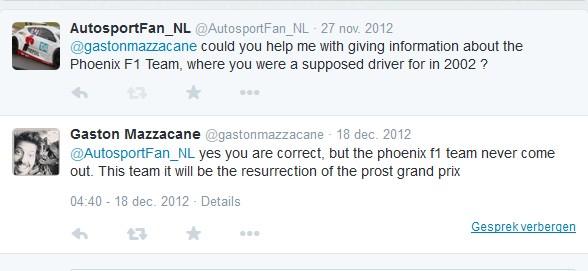
It quickly became clear that the team would not race at the first Grand Prix of 2002 in Australia. Bernie Ecclestone explained that Phoenix had only bought the assets of the folded Prost GP team, and not the entry rights. In addition, the purchase had not been completed with adequate time to allow the team to be present in Melbourne. Nevertheless, two nosecones were submitted to the scrutineers at the event, but they were rejected. At the next race in Malaysia, Phoenix Grand Prix did show up though. It is rumoured that the team were to enter the Grand Prix, but without an up-to-date car. Phoenix arrived on Thursday on a private flight, but the team’s equipment was not allowed to leave the cargo storage at the airport due to issues with their paperwork. In the meantime, both Gastón Mazzacane and Tarso Marques had been spotted at the circuit wandering around, unaware of what was happening. Would they be allowed to drive?
The answer would come quickly. The team, consisting of approximately 50 personnel including the drivers and engineers, and two AP04B cars, were prevented from entering the Sepang paddock. While there are no photos of the Phoenix AP04B, there is some information available concerning the details of the car:
Chassis:
The car was named the Phoenix Grand Prix AP04B – this was basically the Prost AP04 from 2001, however the car had the rear end of the Arrows AX3 Seater – this was the 3-seater car Arrows had designed a couple of years earlier. Rumors suggested that Chassis 3 was actually a Prost AP05 car but it is impossible to have this confirmed. Chassis 01 was a Prost AP04B. The cars appeared to be painted blue with no sponsor colours or logos.
Engine:
The engine is a tricky one to define – the engines also came from the Arrows AX3 Seater, and were labeled as the Arrows T2-F1 V10. These engines had been used by Arrows in their F1 cars in 1998 and 1999, originating from a design by Brian Hart whose engine company was bought by Walkinshaw and merged into Arrows in the middle of 1997.
Tyres:
The tyres were supposed to be provided by Bridgestone, however the Japanese company had already stated in early March that it would be unable supply Phoenix and Michelin said the same. So the most likely option at this point was a supply of Avon tyres, which Minardi had used a year before to shake down their PS01 car with Christijan Albers.
Team:
The team was made up of approximately 50 employees; with most coming from the former Arrows test team and the folded Prost GP. With them were drivers Tarso Marques and Gastón Mazzacane. Managing Director Charles Nickerson stayed at the Arrows base at Leafield where the team were using floor space to prepare the cars. Below is an email from Jon Hilton which provides some insight into the team and the cars:
====
“”I was in charge of the engine programme for the Lola Ford in 1997 as well and was present in Melbourne that year with the team so I am well represented on your list.
There is not much to say about the Phoenix Hart project really. I was told (not asked) by Tom Walkinshaw to spirit two engines out of thin air for the ex Prost cars and get them running in less than 2 weeks. I can’t remember where the first race was to be Singapore or Japan maybe? A long fly away anyway.
The only place I could get engines from at no notice was the two show cars the three-seater ones we had at the time so we pinched those complete with electronics and wiring looms and set to work. The cooling, oil and electronics were not too bad to sort out but mechanically fitting the Hart engine to the back of the Prost tub was more tricky. This was not my part of the job and was done by someone at Leafield, I presume an Arrows guy. The solution they came up with was awful and to me looked unsafe (but to be fair they had no time or room to play with). I personally took Tom to show him the car and explained that I thought it was unsafe. He claimed that to qualify as having taken part the car only needed to run in the garage, then a few days after we had shipped it said that maybe it had to crawl around for one slow lap of the track. I think it could have done this but no more. There were a few rather awkward bits on the car as the Hart engine was longer than the original engine so the wheel base was different and the body work did not line up perfectly.
Two of my guys went out with the cars to the first race but they were denied track access with the cars and instead had a short holiday. I am not sure if they also travelled to the next race and did the same? I think my guys came home after the first one. The project then died pretty quickly and we were all relieved.””
====
Not long after the failed attempt to enter the Malaysian Grand Prix, a name change took place. Instead of Phoenix Grand Prix Ltd., the team name was now DART Grand Prix Team Ltd. It’s not clear why this happened. Bizarrely Tom Walkinshaw used to own a different company in the early 1980s with the name DART which stood for Dunlop Auto Racing Tyres and which prepared Dunlop racing tyres in England.
For the next Grand Prix held in Brazil the new DART team requested to have a pit box reserved because they were certain they would be allowed to enter this time around, but the FIA thought differently and told the team once again they would not be allowed to participate. To make matters worse the FIA told Nickerson that the team would not take part in a single Grand Prix in 2002, which was music to the ears of Paul Stoddart. During the same weekend Craig Pollock was seen frequently by Tom Walkinshaw. Pollock had been replaced as team principal at BAR by Dave Richards at the end of the 2001 season, and rumours quickly spread that he could be the new team manager at Phoenix Grand Prix Team /DART. It would make sense – the team had been considering others for the role including Tony Dowe.
In the meantime Nickerson remained in discussion with the FIA, seeking permission for the team to enter the upcoming Grands Prix. For some time there was light at the end of the tunnel – there was a small chance that the team would be allowed to enter the fourth race of 2002, the San Marino GP. But in the event, the team did not attempt to enter at Imola, with the FIA reiterating that the team was not allowed to enter any Grands Prix during the 2002 season. This statement from the FIA prompted Charles Nickerson to take the FIA to court over the matter to try and force his way onto the F1 grid.
While these events were unfolding, Dart Grand Prix Team Ltd. changed its name back to Phoenix Grand Prix; again, the reasons behind this are unclear. What is more interesting is that Arrows completed a three day test at Silverstone on the week of 14th April. Rumours suggested that Arrows also tested the Phoenix AP04B, but this has not been confirmed. Tomáš Enge was assumed to be the driver spotted during the three day test.
While the Formula One circus marched further into the season, the Phoenix Grand Prix team under the lead of Charles Nickerson went to the High Court in London on 13th May 2002 for an answer in its case against the FIA and FOM, claiming that the two organisations were preventing the team from competing using assets acquired from the defunct Prost Grand Prix. It would take more than a week for the verdict to be delivered. On 22nd May 2002 the High Court ruled that the FIA was in their right to exclude Phoenix from entering Formula One and that Phoenix must pay the court costs associated with the case.
Judge Morritt came to the following conclusion regarding the case:
The court considered the issues relating to Phoenix’s claims, noting that on February 16 Phoenix made an offer to buy assets of Prost Grand Prix for $2.2m. That offer stated that Charles Nickerson, the chief executive of Phoenix, had an arrangement with Tom Walkinshaw for the TWR Group to supply the necessary engines and transmission. There followed detailed negotiation between Phoenix, the liquidator of Prost GP and the FIA over whether or not the team would have any Concorde Agreement rights. The conclusion was that the non-participation in the Australian GP was the result of Prost’s insolvency and so the rights under the Concorde Agreement would no longer exist.
Phoenix did not appear in Australia but two noses cones were submitted to the scrutineers. These were rejected.
The TWR company did not receive the Prost chassis until the Monday and Tuesday after the Australian GP and they were then fitted with engines and gearboxes and sent to Malaysia but the cars were never presented for scrutineering in Malaysia. After that Phoenix commenced its legal actions against the FIA, FOM and FOA.
The judge concluded that none of the Phoenix claims had any validity and ruled against any appeal against the decision.
“Phoenix has not shown a serious issue to be tried entitling it to the final relief it seeks against any of the defendants,” he concluded.
Justice Morritt also ruled that Phoenix Finance Ltd. should pay all costs. These are expected to be in the region of $1.2m.
At this point the future of the Phoenix Grand Prix team was unknown. Facing a big legal bill and no prospect of an F1 entry, Charles Nickerson was non-committal and stated that he would be “considering the future in the light of the extensive judgement and what it means for us as a company”. Paul Stoddart was delighted with the verdict – having the Phoenix team prevented from entering Formula One meant that the small Minardi team would be handed an extra $13 million from the FIA, vital for their own survival.
After this nothing was heard or seen from the Phoenix Grand Prix team. A few races later Tom Walkinshaw’s Arrows team hit financial trouble. The team could not afford the ever-increasing costs of F1 anymore and collapsed following the German Grand Prix. The team’s A23 cars were a fundamentally good design however – Paul Stoddart bought them with a view to using them as replacement to the PS03 in 2004 with Verstappen setting quick times in testing in the car, renamed as the Minardi PS04. Even later down the line, the A23 was used as the basis for Super Aguri’s first F1 car in 2006, the SA05, and while obviously dated and uncompetitive considering the advances made in the preceding years, provided a solid platform for the Japanese team to begin their F1 journey.

